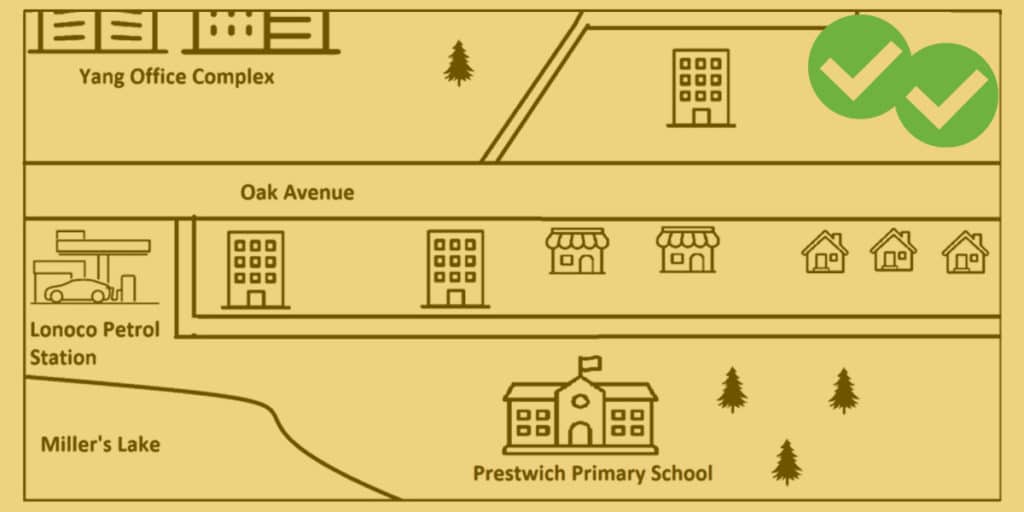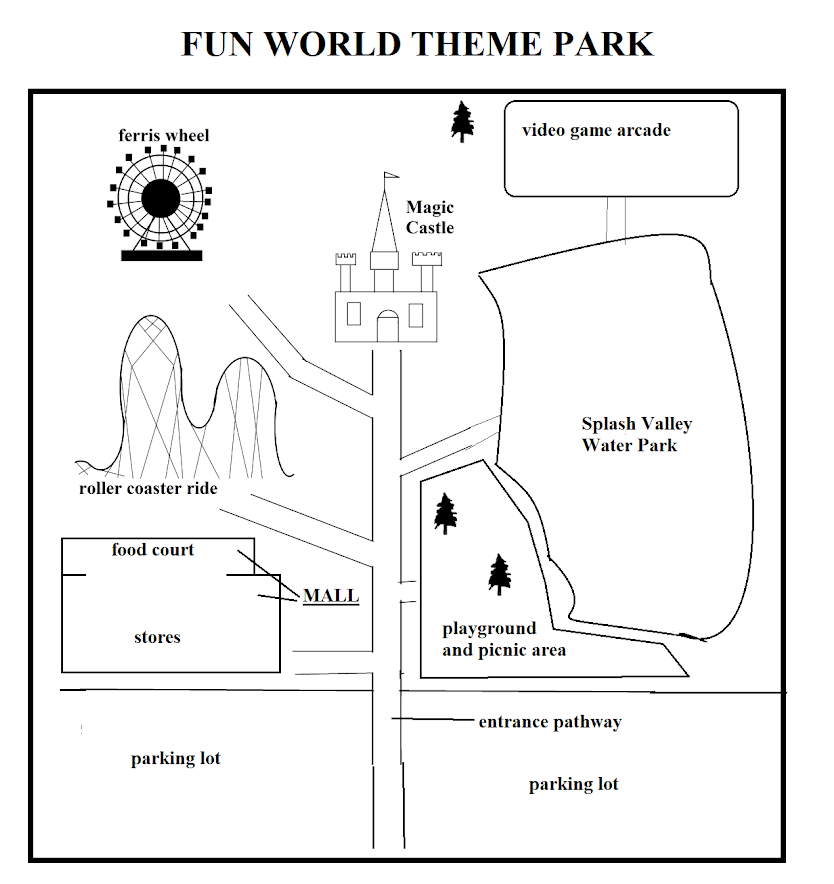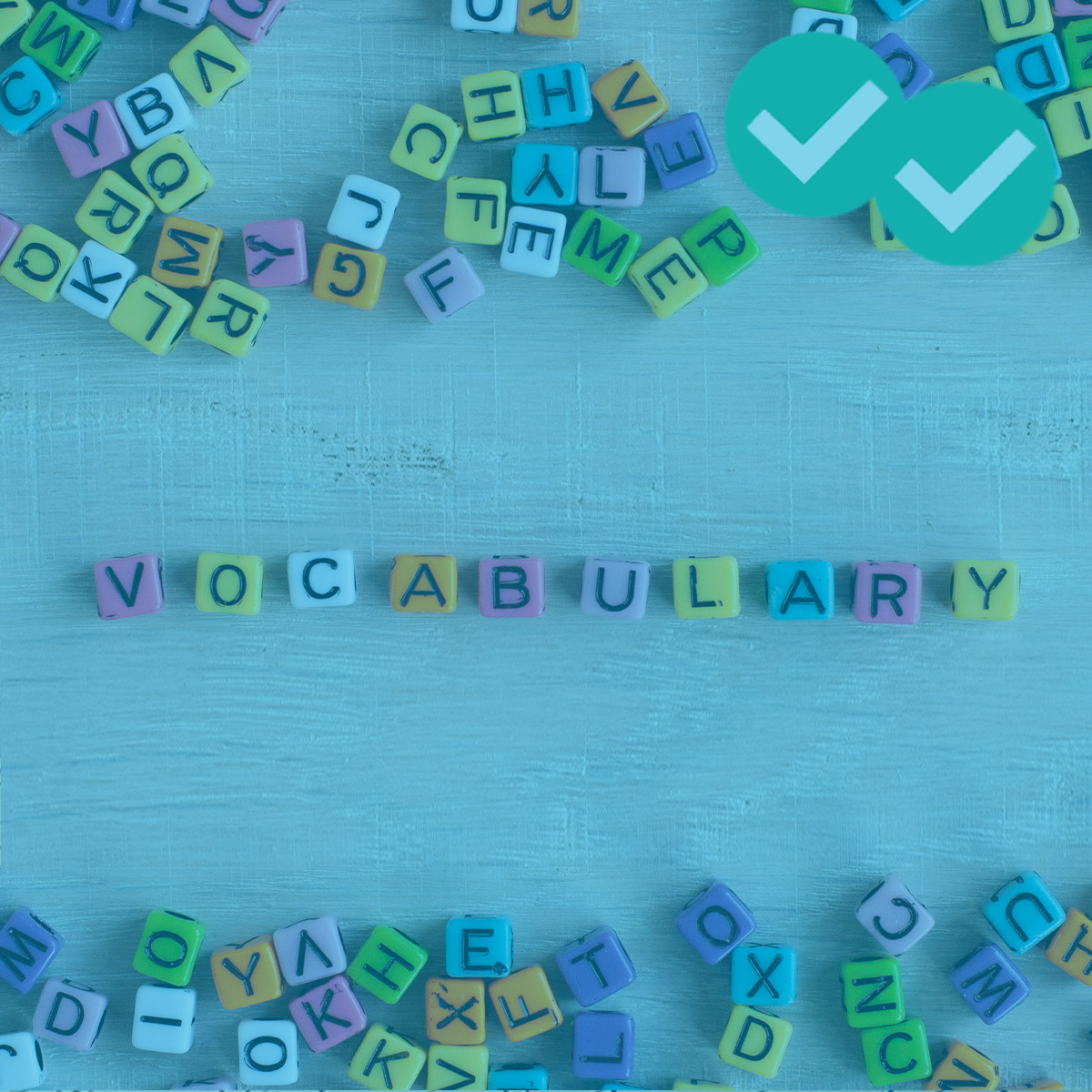 IELTS Academic Writing Task 1 sometimes requires you to describe a map, using key IELTS map vocabulary. Read on to learn all about IELTS Writing Task 1 map vocabulary, and how to put it to good use. And for advice on describing other types of graphics that are common in the first IELTS Writing task, see our post on useful words for writing an IELTS graph essay.
IELTS Academic Writing Task 1 sometimes requires you to describe a map, using key IELTS map vocabulary. Read on to learn all about IELTS Writing Task 1 map vocabulary, and how to put it to good use. And for advice on describing other types of graphics that are common in the first IELTS Writing task, see our post on useful words for writing an IELTS graph essay.
Below, I’m going to walk you through the five steps to writing top-scored IELTS map essays:
- Master the basic vocabulary
- Understand the objectives of the task
- Fully describe the items on the map
- Describe the way elements of the map change (an IELTS Writing map is two part, showing how a place changes)
- Combine all of these skills into a full essay
A full walkthrough of Writing Task 1 maps, including a model essay, can be seen in Eliot’s video above. (You can watch the video now, or check it out later after reading this guide!)
IELTS Map Vocabulary
Before we look at the finer parts of how to write about an IELTS map, let’s think about the basic features of these maps and the IELTS map vocabulary used to describe them. In a nutshell, most IELTS maps will show a large location with buildings and other specific types of areas and locations. And typically, there will actually be two maps: a before and after map. With that in mind, there are three major important categories of vocabulary for describing such maps. For each of the three categories below, I’ve given a partial list of the kids of words you might use. This should give you a general idea, and I would encourage you to think up additional similar words on your own.
Words that Describe the Places
NOUNS:
- building
- housing
- business
- region
- forest
- river
- lake
- entrance
- exit
- road
- bridge
- complex
- district
- facility
ADJECTIVES:
- larger
- smaller
- longer
- shorter
- urban
- rural
- crowded
- broad
- narrow
Words that Describe the Locations of Places
COMPASS WORDS:
- north
- east
- south
- west
- northeast
- southwest
- etc…
- NOTE: Even if a compass does not appear on a map, you can assume that up is north, down is south, left is west, and right is east
DIRECTIONAL WORDS AND PREPOSITIONS:
- left
- right
- above
- below
- inside
- around
- adjacent
- near
- opposite
- across from
Words that Describe Actions and Change
- built
- constructed
- replaced
- extended
- removed
- expanded
- demolished
- renovated
- newly
- mostly
- significant
- substantial
How to Write About an IELTS Map
How to write a map essay in IELTS involves a simple 5 step process:
1. Get Fluent in Basic IELTS Map Vocabulary
Develop your skills and knowledge for words that describe places, where places are located in relation to each other, and how places change in IELTS Writing maps. The lists I’ve provided are a great place to start.
2. Understand The Objectives
To tackle the challenge of describing a map for the exam, you must understand the objectives of the task at hand. Importantly, while 75% of your score represents your linguistic performance (coherence and cohesion, vocabulary, and grammar), 25% depends on your achievement of the task.
Earning a high band score for task 1 completion is awarded for a “clear overview of main trends, differences, or stages.” If a clear overview cannot be achieved, you must minimally highlight the key features related to the prompt.
With this in mind, check out the image below:

If we want to consider key features or trends, it wouldn’t be enough to say that there are rides, recreational areas, and places where goods can be purchased. This doesn’t provide any overviews; it simply lists elements. Noting patterns and overall “trends” requires looking at the bigger picture, not isolated elements. An overview might point out instead that rides and tours tend to be farther from the parking area (i.e. the roller coaster, Ferris wheel, and magic castle), and that places where visitors can rest are closer to the theme park entrance (i.e. the food court and the playground/picnic area).
But you probably won’t be given an image and simply told, “describe it.” Instead, you will be given a specific task, and you will use the information in the image to complete it. For example, for the image above, a the full task is actually to describe the key features and differences between the current layout of the theme park, and the way the theme park will look after some planned future changes.
3. Go Beyond Naming
Ultimately, your task requires more than mere description. While nouns are obviously important (for naming various structures and natural elements and their basic positions on the map), task completion involves more than listing items. Describing trends, differences, or stages requires noting the relationship among elements and between images for comparison. Remember, there’s far more to IELTS Writing Task 1 vocabulary than just the names of things.
Imagine that your task is to examine before and after illustrations of a neighborhood over the course of a century.

For this task, it is clearly not enough to name what is new. Don’t just describe what’s there, describe the relationship between what’s there.
For example, do not simply say “there is an office complex that wasn’t there before.” What relationship does this have to the big picture? Remember, you must be able to provide an overview.
| NO: | YES: |
|---|---|
| There was a cannery. | The cannery was along the northwest side of Oak Avenue. |
| There is a main road and side roads. | The main road is connected to side roads that are closer to the lake and river. |
| There is a petrol station. | There is a petrol station on the other side of the road from the Yang Office Complex. |
| There are two shops. | The main road currently has two shops between some apartment buildings and homes. |
| There was a smaller elementary school. | The smaller elementary school sat on the north side of Miller’s Lake. |
4. Describe the Changes Between the Two Maps
But, wait! Your overview shouldn’t just mention elements and their relationship to one another. How are the elements that you’re describing relevant to the prompt? What changes have been made? We must connect these observations to the before and after context, reflecting change:
- The cannery along the northwest side of Oak Avenue was replaced by an office complex.
- The main road is connected to side roads that are closer to the lake and river. In the second map, the road that ended near the river now goes over the river via bridge.
- There is a petrol station on the other side of the road from the Yang Office Complex, where the elementary school had been on the older map.
- The main road currently has two shops, where previously there had been just one shop. These shops sit between the more recently constructed apartment buildings and an expanded set of homes.
- The smaller elementary school on the north side of Miller’s Lake was expanded and moved to the east side of the lake.
Now that’s more like it! Always remember that the IELTS Writing Task 1 map comparison between the old and new features is very important.
5. Put These Skills Together into a Full Essay
At this point, you’ve mastered the basic vocabulary, made your descriptions of the places on the map more detailed, and learned to describe change between two maps. Of course, these are just a few of many ways you could describe the map above. Your final step is to apply all this knowledge to map essays of your own creation. Try writing your own essay about the map above, or create an essay based on our full set of IELTS Writing Task 1 practice questions. That set includes a link to the full model IELTS Writing Task 2 essay based on the map above.
Final Takeaways For Using IELTS Writing Task 1 Map Vocabulary
Main takeaways for using IELTS map vocabulary to compare and describe an IELTS map:
- Remember that the examiner is looking for an overview with main points, not an exhaustive list of elements.
(Notice, for example that I didn’t precisely quantify housing units, describe exact comparative distances, or give the exact names of every location.) - Think of the big picture. Rather than focusing on what’s there, think about how they’re related to the overall developments.
- Don’t forget your primary task – What changes have been made? What occurred, resulting in the differences you see?
Check out more helpful articles on the use of IELTS Writing Task 1 map vocabulary (and this bonus IELTS Video!) on preparing for the IELTS Academic Writing Task 1:






Leave a Reply